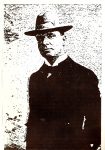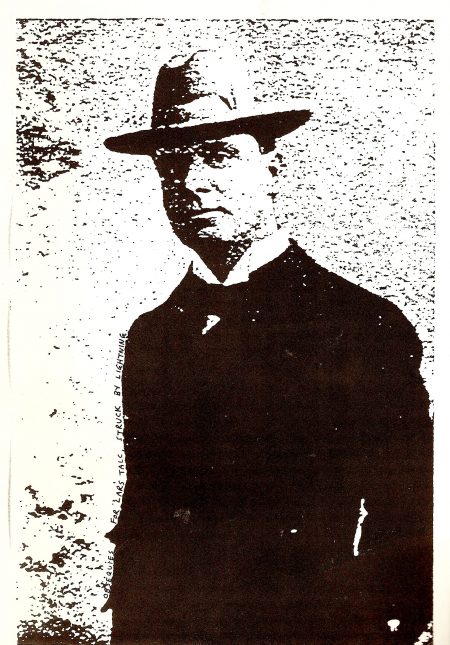
Minnie threw herself into the funeral arrangements with astonishing energy. At ninety-seven, she was three years older than Talc, but the years had not dimmed her eupeptic zest. As executrix of the estate, she accosted Chodd – thinking he was Batlip – within seconds of the will being screeched.
“I will be in charge of the funeral, down to the tiniest detail,” she rapped, “You, Aloysius, will do my bidding. Your first task is to arrange for the Bosnian nerve gas billionaire, Turps Potcap, to be at my apartment at ten o clock tomorrow morning on the dot. Meanwhile, Talc is to be refrigerated at the lowest possible temperature you can manage. Snap to it.”
At ten o clock the next morning, Turps Potcap was ushered in to Minnie’s sitting-room. He was almost as wizened as she, but a quarter of a century younger. Born of Bosnian lumpenproles who died of the groist when he was a mere tot, Potcap was brought up in a frolicsome orphanage run by the famed reformer Hattie Brinks. At fourteen he was already displaying his formidable intellectual gifts, delivering lectures on a variety of abstruse subjects to his dumbstruck peers.
Mistress Brinks enrolled him at the University of Tuzla, where he soon humiliated his teachers by addressing them in fluent Coptic, a language none of them understood. Before his sixteenth birthday, Potcap was appointed Corncrake Professor of Physics at a crumbling but important university in Burma, a post he held until he was forty. By then, however, he had invented a nerve gas of staggering power, which he patented and sold in vast quantities to governments around the world.
The effects of Potcap’s gas, on one exposed to it, are temporary but devastating. The victim invariably runs to the nearest tobacconist, buys a huge quantity of cigarettes, slumps to the ground and sits, babbling, gesticulating, and smoking heavily, like a student. Meanwhile, the tanks, artillery, and special operations militia move in, and by the time the effects of the gas wear off, a couple of days later, the commanding heights of the socio-economic infrastructure are in the hands of the invading forces.
Potcap made an absolute fortune, of course, and retired from academia. He lived simply, spending much of his time engaged in various secretive and pointless research projects, but occasionally hiring himself out as a “special consultant”. He had, for example, designed a new whisk for a utensils conglomerate, written a lengthy report on pigeons’ blood at the behest of the Hooting Yard Foundation, conducted dangerous experiments at an international hot air ballooning conference, and solved the bogus laundry murder case, which had befuddled the minds of the Dutch police for six years. With such a pedigree, he was Minnie’s natural choice to organise Lars Talc’s funeral.
She steered Potcap to an armchair and gave him a mug of soup.
“Thank you for coming at such short notice,” she said, “First of all, I must ask you if you are familiar with Talc and his work?”
“I am not,” replied Potcap.
“Splendid!” shouted Minnie, unnecessarily loudly, “I am so glad. The Finns think they know Talc, you see, they think they understand him. That’s why I have asked you here, because you will approach the task objectively. You will bring no mental baggage in your train.”
“What is this task you speak of?”
“I wish you to organise Talc’s funeral, Mr Potcap,” said Minnie.
The Bosnian billionaire was startled. “O is he dead then?”
“Two days ago he was struck by lightning. Here is a newspaper clipping. You may keep it if you wish.”
Potcap read Battista Ritnob’s brief report, then tucked it carefully into his wallet.
“If I may say so, madam, you have made an excellent choice in selecting me for this task,” he announced. “Although I have never organised a funeral before, I am more than equal to the challenge. Is he to be buried or burned?”
“Buried,” said Minnie.
“Good. Humans are the only creatures who bury their dead. The fact is of fundamental significance. Palaeolithic peoples not only buried their dead, madam, but they provided them with food and other equipment, implying a belief that the dead still needed such things in the grave. Tosh it may be, but significant tosh, highly significant, eh?”
“Talc spurned all religion and other shilly-shallying.”
“As I do myself, madam,” said Potcap, gulping down his soup. “Nevertheless, burial of the dead stems from an instinctive inability or refusal to accept death as the definitive end of life.”
Minnie snorted. “What else can you do with a corpse?” she asked.
“Burn it,” said Potcap, “Or leave it where it is. But let that pass. Talc shall be buried. As he was not a Christian, I suppose you do not wish the funerary ceremonies to be invested with a sombre character, the visible expression of which would be the use of black vestments, and candles of unbleached wax and the solemn tolling of a church bell, the corpse being carried in a doleful cortege of clergy and mourners, with the intoning of psalms and the purificatory use of incense, and, the coffin being deposited in the church, it being covered with a black pall, and the Office of the Dead recited or sung, with the constant rendition of Eternal rest grant unto him, O Lord, and let perpetual light shine upon him, followed by the recitation of the Requiem Mass, with the sacrifice especially offered for the repose of the soul of the dead, then the absolution of the deceased, the coffin solemnly perfumed with incense and sprinkled with holy water, before being carried to consecrated ground and buried while the officiating priest whines a litany of appropriate prayers?”
Minnie spat.
“I would rather lie on my back at the bottom of a pond than take part in such trumpery! No, Mr Potcap, I have very clear ideas about Talc’s funeral. You will need to take notes. While I fetch more soup, you had better sharpen your pencil. Here is a wastepaper basket for the shavings.”
Turps Potcap sharpened his pencil. Minnie brought two mugs of boiling soup.
“The funeral will take place in three days’ time,” she said, “You will have lots of work to do. Now listen carefully. Including you and me, there will be twenty-six mourners, selected on an alphabetic basis. I will give you the names later. If anyone else tries to attend, Bruno will frighten them away. He has a talent for scarifying.
“We will gather at dawn in the gazebo on Pilgarlic Hill, to which Batlip will have delivered Talc in his coffin the night before. There will be a funeral breakfast, consisting of porridge, ships’ biscuits, and whey. We will then form a cortege, each mourner travelling separately in a different form of transport. Batlip’s hearse will be at the front, of course, and immediately behind it me, borne on a palanquin. The other carriages will be a landau, a motorbike, a rickshaw, a charabanc, a covered wagon, a brancard, a tumbrel, an ekka, a scooter, a tilbury, a van, an ambulance, a coach-and-four, a mail-phaeton, a jalopy, a huskie-drawn sled, a bicycle, a hard-top, a wheelchair, a truck, a go-kart, a diligence, a brake, a clunker, and a gig. I have you down for the tumbrel, Mr Potcap, I trust that will be satisfactory?”
“Of course, madam,” said the billionaire, writing frantically.
“Good. We will proceed at a stately pace, with much wailing and gnashing of teeth. Our route will take us past the Cow & Pins, Talc’s favourite drinking-hole. We will all disembark, enter the tavern, and drink heavily. You will have to ensure that the landlord is apprised of our visit, and has in stock many barrels of a special funereal brew. We will not leave until every last drop of it is drunk. Communal ablutions will then take place in the lavatories, after which the cortege will make its way to the Gravelflap Building in the town square.
“The coffin will be carried in on a bier. We mourners will remain outside, where we will eat hockey cake, count noses, drape a toad in ermine, and break into bits a mustard canister. That done, we will enter the building and take our seats. Dr Hoist will then sing song number one hundred and four from Talc’s songbook. It is a dirge of inordinate length, entitled The Grist, The Sack, The Perfume Of Lack. We shall all join in for the chorus. While Hoist moans, Finnish Airline Belles will distribute sprigs of watercress soaked in vinegar, which the mourners will entangle in their hair. Have you got all this written down? Good. We will then applaud immoderately as the Reverend Chew appears in the pulpit.”
“Madam?”
“What?”
“A reverend? I thought you said Talc abhorred religion?”
“He did. But the Reverend Chew is an old friend. His mother and Talc’s mother killed horses together when they were children. He and Talc spent many happy hours side by side, laying plans for a fundamental reform of Finnish cartography. Their innovative map-reading techniques were revolutionary, and even today have not won popular acceptance. It is quite impossible to imagine Talc’s funeral without the Reverend Chew taking part in the obsequies.
“When, after about ten minutes, the mourners have stopped cheering, Chew will deliver his sermon. If I know Chew, it will be a thing of magnificence. There will then be a little concert. I have arranged for a small ensemble of bassoon, sackbut, and twin accordions to play some dreadfully lugubrious pieces. I will then take centre stage and pound my madge upon an anvil, the very picture of hysterical bereavement. Ensure, Mr Potcap, that quick sketches of me are executed at this point. You will find plenty of able scribblers in the directory.
“You will then unleash into the building a sleuth of bears, a chattering of choughs, a sedge of herons, a drift of swine, a congregation of plovers, a cete of badgers, and a husk of hares. Talc was fond of animals. Do not forget to contact the zoo, which must provide not only the beasts but their keepers. Their frolicking done, the animals will be mesmerised by the quack Pillchain, and carted off to the place of interment, whither we too will follow, after lunching on fudge and toffee in the Gravelflap cafeteria.
“When we arrive at the cemetery, I want each mourner to be given an urn to blub into. Batlip and his henchman will varnish the coffin with a stinking substance, and it will be lowered into an enormous pit. We shall stand in a circle around it, sobbing, bereft, but dignified. The animals will be loosed among the tombstones. A troupe of minstrels will prance and caterwaul. Milk, feathers, sand, and fragments from the skull of an osprey will be tossed into the pit. The Reverend Chew will jabber. The sky will darken. We will shuffle away, each lost in our thoughts, going our separate ways, and never gather together again. There. That will be the funeral of Lars Talc.”





